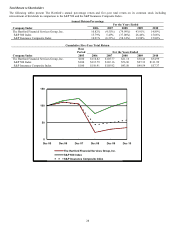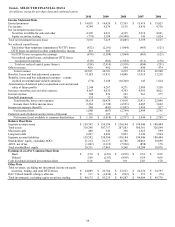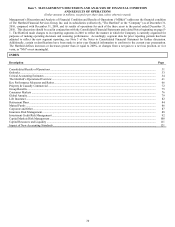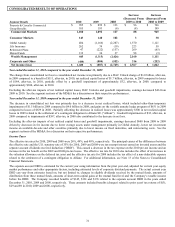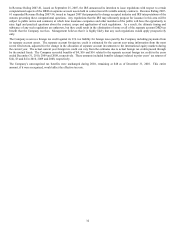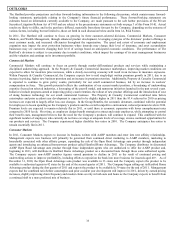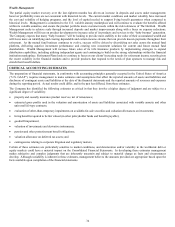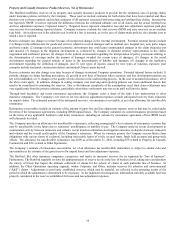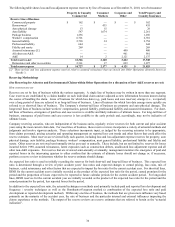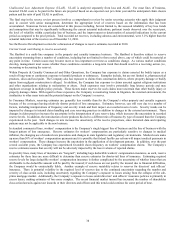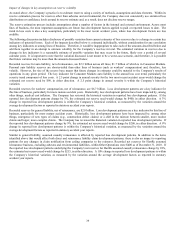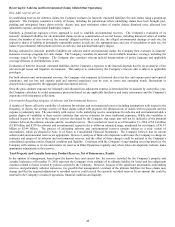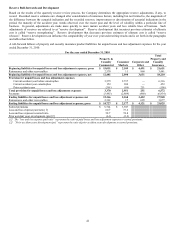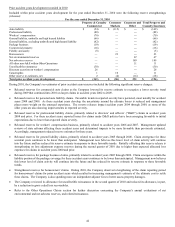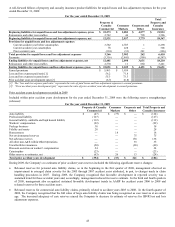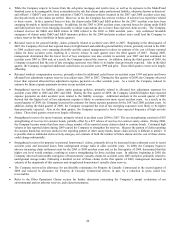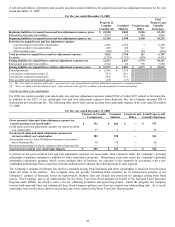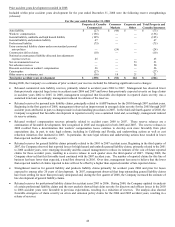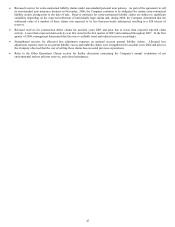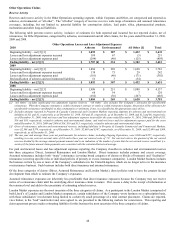The Hartford 2010 Annual Report Download - page 38
Download and view the complete annual report
Please find page 38 of the 2010 The Hartford annual report below. You can navigate through the pages in the report by either clicking on the pages listed below, or by using the keyword search tool below to find specific information within the annual report. 38
Unallocated Loss Adjustment Expense (ULAE). ULAE is analyzed separately from loss and ALAE. For most lines of business,
incurred ULAE costs to be paid in the future are projected based on an expected cost per claim year and the anticipated claim closure
pattern and the ratio of paid ULAE to paid loss.
The final step in the reserve review process involves a comprehensive review by senior reserving actuaries who apply their judgment
and, in concert with senior management, determine the appropriate level of reserves based on the information that has been
accumulated. Numerous factors are considered in this process including, but not limited to, the assessed reliability of key loss trends
and assumptions that may be significantly influencing the current actuarial indications, pertinent trends observed over the recent past,
the level of volatility within a particular line of business, and the improvement or deterioration of actuarial indications in the current
period as compared to the prior periods. Total recorded net reserves, excluding asbestos and environmental, were 3.2% higher than the
actuarial indication of the reserves as of December 31, 2010.
See the Reserve Development section for a discussion of changes to reserve estimates recorded in 2010.
Current trends contributing to reserve uncertainty
The Hartford is a multi-line company in the property and casualty insurance business. The Hartford is therefore subject to reserve
uncertainty stemming from a number of conditions, including but not limited to those noted above, any of which could be material at
any point in time. Certain issues may become more or less important over time as conditions change. As various market conditions
develop, management must assess whether those conditions constitute a long-term trend that should result in a reserving action (i.e.,
increasing or decreasing the reserve).
Within Property & Casualty Commercial and Other Operations, the Company has exposure to claims asserted for bodily injury as a
result of long-term or continuous exposure to harmful products or substances. Examples include, but are not limited to, pharmaceutical
products, silica and lead paint. The Company also has exposure to claims from construction defects, where property damage or bodily
injury from negligent construction is alleged. In addition, the Company has exposure to claims asserted against religious institutions
and other organizations relating to molestation or abuse. Such exposures may involve potentially long latency periods and may
implicate coverage in multiple policy periods. These factors make reserves for such claims more uncertain than other bodily injury or
property damage claims. With regard to these exposures, the Company is monitoring trends in litigation, the external environment, the
similarities to other mass torts and the potential impact on the Company’ s reserves.
In Consumer Markets, reserving estimates are generally less variable than for the Company’ s other property and casualty segments
because of the coverages having relatively shorter periods of loss emergence. Estimates, however, can still vary due to a number of
factors, including interpretations of frequency and severity trends and their impact on recorded reserve levels. Severity trends can be
impacted by changes in internal claim handling and case reserving practices in addition to changes in the external environment. These
changes in claim practices increase the uncertainty in the interpretation of case reserve data, which increases the uncertainty in recorded
reserve levels. In addition, the introduction of new products has led to a different mix of business by type of insured than the Company
experienced in the past. Such changes in mix increase the uncertainty of the reserve projections, since historical data and reporting
patterns may not be applicable to the new business.
In standard commercial lines, workers’ compensation is the Company’ s single biggest line of business and the line of business with the
longest pattern of loss emergence. Reserve estimates for workers’ compensation are particularly sensitive to changes in medical
inflation, the changing use of medical care procedures and changes in state legislative and regulatory environments. Medical costs make
up more than 50% of workers’ compensation payments and it is possible that federal health care reform will impact medical payments in
workers’ compensation. These changes increase the uncertainty in the application of development patterns. In addition, over the past
several accident years, the Company has experienced favorable claim frequency on workers’ compensation claims. The Company’ s
reserve estimates assume that severity will not be adversely impacted by the lower volume of reported claims.
In specialty lines, many lines of insurance are “long-tail”, including large deductible workers’ compensation insurance, as such, reserve
estimates for these lines are more difficult to determine than reserve estimates for shorter-tail lines of insurance. Estimating required
reserve levels for large deductible workers’ compensation insurance is further complicated by the uncertainty of whether losses that are
attributable to the deductible amount will be paid by the insured; if such losses are not paid by the insured due to financial difficulties,
the Company would be contractually liable. Another example of reserve variability relates to reserves for directors’ and officers’
insurance. There is potential volatility in the required level of reserves due to the continued uncertainty regarding the number and
severity of class action suits, including uncertainty regarding the Company’ s exposure to losses arising from the collapse of the sub-
prime mortgage market. Additionally, the Company’ s exposure to losses under directors’ and officers’ insurance policies is primarily in
excess layers, making estimates of loss more complex. The recent financial market turmoil has increased the number of shareholder
class action lawsuits against our insureds or their directors and officers and this trend could continue for some period of time.


